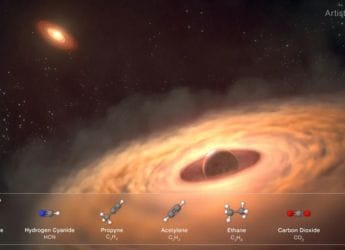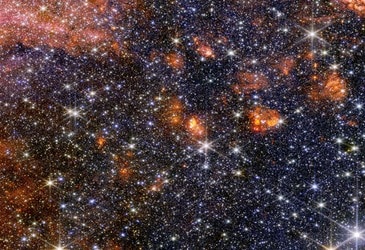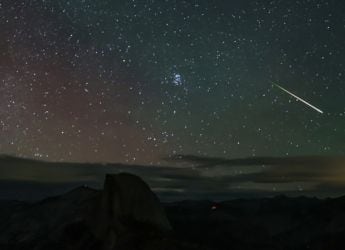- Home
- Science
- Science News
- Deep Sea Beryllium 10 Hints at Supernova Debris Reaching Earth 10 Million Years Ago
Deep-Sea Beryllium-10 Hints at Supernova Debris Reaching Earth 10 Million Years Ago
Deep-sea isotope spikes may point to a supernova showering Earth with debris 10 million years ago.

Photo Credit: phys.org
Deep-sea isotope spikes suggest Earth was hit by supernova debris 10 million years ago.
Scientists studying deep-sea crusts have uncovered chemical clues that suggest, 10 million years ago, Earth was showered with debris from an exploding star. Researchers identified a radioactive isotope formed when cosmic rays strike Earth's atmosphere, unusually high levels of Beryllium-10, and buried in the Pacific Ocean. However, alternative explanations exist and it torch towards a possible nearby supernova as the cause. In addition, if it is confirmed, this discovery helps to polish our understanding of how cosmic events have left imprints on our planet's geological history.
Deep-Sea Isotope Evidence Strengthens Case for Ancient Supernova Near Earth
According to a study published in Astronomy & Astrophysics, researchers traced the orbits of 2,725 star clusters over 20 million years. It focuses on determining if a supernova could have exploded close to Earth at the time of the isotope spike. The evaluation demonstrated a 68% chance that such an event occurred within 100 parsecs, or around 326 light-years. The may be a closer explosion, around 35 parsecs away. The team also highlighted 19 clusters with significant chances of producing such a supernova.
The scientists explained that while the isotope spike could be linked to shifting ocean currents, the cosmic scenario remains strongly supported. Researchers pinpointed two star clusters in the Orion region, ASCC 20 and OCSN 61, as potential sources of a significant star explosion. They emphasise the necessity for further isotope records globally to determine if the anomaly originated from space or local terrestrial processes.
Researchers suggest that the excess Beryllium-10 may indicate a supernova origin, but confirming these findings in independent crust samples is crucial for resolution.
The study also explores the link between cosmic explosions and their potential historical impacts on Earth. If it is validated, this helps to enhance our understanding of how interstellar events affect planetary environments and also life's conditions. The investigation with deep-sea signatures serves as significant evidence of Earth's exposure.
For the latest tech news and reviews, follow Gadgets 360 on X, Facebook, WhatsApp, Threads and Google News. For the latest videos on gadgets and tech, subscribe to our YouTube channel. If you want to know everything about top influencers, follow our in-house Who'sThat360 on Instagram and YouTube.
Related Stories
- Samsung Galaxy Unpacked 2025
- ChatGPT
- Redmi Note 14 Pro+
- iPhone 16
- Apple Vision Pro
- Oneplus 12
- OnePlus Nord CE 3 Lite 5G
- iPhone 13
- Xiaomi 14 Pro
- Oppo Find N3
- Tecno Spark Go (2023)
- Realme V30
- Best Phones Under 25000
- Samsung Galaxy S24 Series
- Cryptocurrency
- iQoo 12
- Samsung Galaxy S24 Ultra
- Giottus
- Samsung Galaxy Z Flip 5
- Apple 'Scary Fast'
- Housefull 5
- GoPro Hero 12 Black Review
- Invincible Season 2
- JioGlass
- HD Ready TV
- Laptop Under 50000
- Smartwatch Under 10000
- Latest Mobile Phones
- Compare Phones
- Realme 15x 5G
- OPPO A6 5G
- Samsung Galaxy M07
- Xiaomi 17
- Xiaomi 17 Pro Max
- Xiaomi 17 Pro
- Xiaomi 15T Pro
- Xiaomi 15T
- Asus Vivobook S16 (S3607QA)
- Gigabyte AORUS Master 16
- Samsung Galaxy Tab A11+
- Xiaomi Pad 8
- Xiaomi Smart Band 10 Glimmer Edition
- Xiaomi Watch S4 41mm
- Xiaomi Xiaomi TV S Pro Mini LED 55 2026
- Xiaomi TV S Pro Mini LED 65 2026
- Asus ROG Ally
- Nintendo Switch Lite
- Haier 1.6 Ton 5 Star Inverter Split AC (HSU19G-MZAID5BN-INV)
- Haier 1.6 Ton 5 Star Inverter Split AC (HSU19G-MZAIM5BN-INV)

















